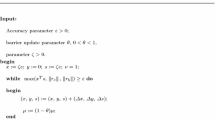Abstract
Sometimes an optimization problem can be simplified to a form that is faster to solve. Indeed, sometimes it is convenient to state a problem in a way that admits some obvious simplifications, such as eliminating fixed variables and removing constraints that become redundant after simple bounds on the variables have been updated appropriately. Because of this convenience, the AMPL modeling system includes a “presolver” that attempts to simplify a problem before passing it to a solver. The current AMPL presolver carries out all the primal simplifications described by Brearely et al. in 1975. This paper describes AMPL’s presolver, discusses reconstruction of dual values for eliminated constraints, and presents some computational results.
Preview
Unable to display preview. Download preview PDF.
Similar content being viewed by others
References
IEEE Standard for Binary Floating-Point Arithmetic, Institute of Electrical and Electronics Engineers, New York, NY, 1985.
IEEE Standard for Radix-Independent Floating-Point Arithmetic, Institute of Electrical and Electronics Engineers, New York, NY, 1987.
“Optimization Subroutine Library Guide and Reference, Release 2,” SC23-0519- 03, IBM Corp., 1992.
Using the CPLEX Callable Library and CPLEX Mixed Integer Library, CPLEX Optimization, Inc., 1992.
Brearley, A. L.; Mitra, G.; and Williams, H. P. (1975), “Analysis of Mathematical Programming Problems Prior to Applying the Simplex Method,” Math. Programming, Vol. 8, 54–83.
Dongarra, J. J. and Grosse, E. (May 1987), “Distribution of Mathematical Software by Electronic Mail,” Communications of the ACM, Vol. 30 No. 5, 403–407.
Fourer, R.; Gay, D. M.; and Kernighan, B. W. (1990), “A Modeling Language for Mathematical Programming,” Management Science, Vol. 36 No. 5, 519–554.
Fourer, R.; Gay, D. M.; and Kernighan, B. W., (1993), AMPL: A Modeling Language for Mathematical Programming, The Scientific Press.
Gay, D. M. (1985), “Electronic Mail Distribution of Linear Programming Test Problems,” COAL Newsletter No. 13, 10–12.
Hung, M. S.; Rom, W. O.; and Waren, A. D., (1993), Optimization with OSL, The Scientific Press.
Lustig, I. J.; Marsten, R. E.; and Shanno, D. F. (1991), “Computational Experience with a Primal-Dual Interior Point Method for Linear Programming,” Linear Algebra and Rs Applications, Vol. 152, 191–222.
Murtagh, B. A., (1981), in Advanced Linear Programming: Computation and Practice, McGraw-Hill, New York (1981).
Murtagh, B. A. and Saunders, M. A. (1982), “A Projected Lagrangian Algorithm and its Implementation for Sparse Nonlinear Constraints,” Math. Programming Study, Vol. 16, 84–117.
Murtagh, B. A. and Saunders, M. A., (1987), “MINOS 5.1 User’s Guide,” Technical Report SOL 83 - 20R, Systems Optimization Laboratory, Stanford University, Stanford, CA.
Vanderbei, R. J. (1991), “A Brief Description of ALPO,” OR Letters, Vol. 10, 531–534.
Vanderbei, R. J., (1992), “LOQO Users Manual,” Report SOR 92-5, Princeton University.
Vanderbei, R. J. (1993), “ALPO: Another Linear Program Optimizer,” ORSA J. Computing, Vol. 5 No. 2, 134–146.
Vanderbei, R. J. and Carpenter, T. J. (1993), “Symmetric Indefinite Systems for Interior-Point Methods,” Math. Programming (to appear).
Author information
Authors and Affiliations
Editor information
Editors and Affiliations
Rights and permissions
Copyright information
© 1994 Kluwer Academic Publishers
About this chapter
Cite this chapter
Fourer, R., Gay, D.M. (1994). Experience with a Primal Presolve Algorithm. In: Hager, W.W., Hearn, D.W., Pardalos, P.M. (eds) Large Scale Optimization. Springer, Boston, MA. https://doi.org/10.1007/978-1-4613-3632-7_8
Download citation
DOI: https://doi.org/10.1007/978-1-4613-3632-7_8
Publisher Name: Springer, Boston, MA
Print ISBN: 978-1-4613-3634-1
Online ISBN: 978-1-4613-3632-7
eBook Packages: Springer Book Archive




